

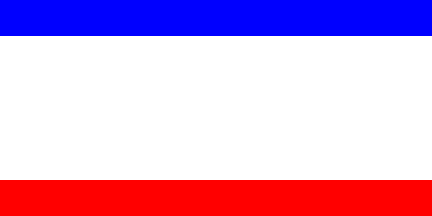
KRIM |
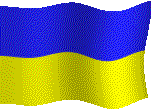
UKRAINE UKRAINA |
6 SEPTEMBER
CRIMEA: SUDAK & JOURNEY TO ODESSA
Great Wall of China ?
SUDAK Yevgeny had suggested that I go to Marble Cave, but I was more attracted to the Genoese heritage of Crimea and the historic links with the Silk Road. So, Sudak had to be the place to go before taking the evening train to Odessa.
 The Trident, Ukraine's national symbol. First appeared as the symbol
of Prince Vladimir (Volodymir) of Kyiv.
The Trident, Ukraine's national symbol. First appeared as the symbol
of Prince Vladimir (Volodymir) of Kyiv.
We sped eastwards across the flat central Crimean plains. Grassy patches, wheat fields and occasional bogs. We also passed a town called Bilohirsk, or “White Mountain” – one could see the sharp vertical white cliffs rising up from the plains. Some new Tatar villages stood nearby, with their lush vegetable fields, freshly painted walls and shiny conjugated roofs. Many Tatars, however, remain in trailers and shacks, awaiting the completion of more permanent homes. The Tatars have been forced to move into these unoccupied lands, since their ancestral houses are now occupied by the new comers. I wonder if this is a good thing. In effect, they are being ghettoised and live apart from the other ethnic groups of Crimea. This may well put them on collision course with others, especially the local Russians.
We reached Sudak after two hours of continuous driving. An impressive 14th century ring of tall brown walls and towers stood on a seaside cliff overlooking this ancient town. This was once one of Genoa’s most important trading ports, and one of the terminal points of the Silk Road. The wealth of the East, carried across the plains and deserts of Eurasia, passes through Sudak on its way to Genoa and the West. Marco Polo’s father and uncle reportedly stopped here on their way to China. But the city’s history dated to a much earlier period before that. Sudak started its existence as a Greek city, and was subsequently conquered, sacked and rebuilt by each of Crimea’s invaders – Scythians, Khazars, Mongols, Genoese, Venetians, Ottoman Turks/Tatars, and Russians.
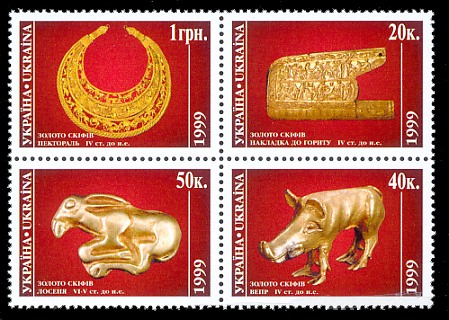 Stamps showing Scythian artifacts.
Stamps showing Scythian artifacts.
Neal Ascherson, in “Black Sea” mentioned about visiting an ancient Khazar tomb dug among Byzantine foundations here. The Khazars were an ancient Turkic nomadic tribe who converted to Judaism in the 8th century AD, many of whom settled in Crimea and the Ukrainian plains, and traded the agricultural produce of the rich black soil for exuberant golden crafts of all kinds that the Greek craftsmen were famous for - adornments and jewelry, drinking vessels with their intricate carvings. Given the fast-growing population of the small Greek city-states, it wasn’t long before they became highly dependent on the wheat of faraway colonies on the Black Sea coast and Sicily. On the other hand, many Khazars lived near or within the Greek cities, acquiring a taste for the more sophisticated cosmopolitan lifestyle they offered. The Khazar tomb Ascherson visited was unusual, for not only was it a Turkic burial performed with Jewish ritual in a Greek Orthodox Christian city, but that it also contained the skeleton of a human sacrifice. According to Ascherson, “the victim – brained by an axe blow – was thrown into the tomb to lie beside its Khazar occupant” in true nomadic tribal traditions.
Sudak declined after the Ottoman capture of Constantinople and eventually of Sudak itself. From an international trading port, it became a provincial agricultural administrative centre whose official records pertain to local farmland disputes rather than international geopolitics. Its role was further diluted when the profitable slave trade was moved to nearby Kaffa, now known as Feodosia.
Sudak is today a sleepy seaside resort, certainly none as exciting as Yalta. A few sun-tanners lie on the beach, and some fun-seekers were water-skiing on its calm waters. At Yevgeny’s urging, I joined holidaymakers at Novy Svet, or “New World”, an even sleepier resort a few miles away. We walked along a narrow path on the water edge of a sea-clinging mountain, and found ourselves in a huge cave which was once the party hall of a local tycoon. The Tsar, members of the nobility, the nouveau riche of Russia’s late 19th century industrialisation, the oil tycoons of Baku, the fashionable chic of High Society St Petersburg all fought to attend the legendary parties once held here. One can still see remnants of the huge wine barrels and cellars in this party cave. What about a bottle of vintage Massandra Sauvignon Blanc ?
“It was time to return to Simferopol,” Yevgeny said. There wouldn’t
be enough time to visit nearby Feodosia, where the Turks and Tatars once
ran the largest slave market in the Black Sea region. Kaffa, as it
was then known, was frequently referred to by the Russians as “the vampire
that drinks the blood of Rus”.
To Odessa
We had tasty borshch soup at Yevgeny’s home and then I bid farewell to Yevgeny’s hospitable family. Vera even prepared a little bag with sweets, chocolates, cookies and apples for basic subsistence on the train. I boarded the train not long before departure time, as I was stopped and examined by the police. Passport ? Da. OVIR ? Da. And off I went, after saying farewell to Yevgeny.
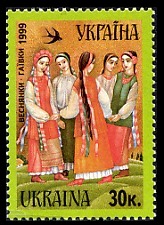 The
train departed on time at 5:05pm, and was to travel across Crimea into
“mainland Ukraine proper”. This was the once “empty land” of Novorossiya,
where the merciless wars between the Tatars and the Cossacks emptied the
land of inhabitants. There the wide steppes once dominated the horizon
– flat endless landscape with nothing but prairie grass and starfield of
flowers, the monotony of which, according to Anna Reid in Borderland, was
occasionally broken by scattered willow trees and burial mounds of ancient
nomadic warriors. Travellers once called it the ocean of grass not
for any other reason. It was a pity that I merely skirted along the southern
edges of this ocean, which in any case, had been largely replaced in Stalinist
times by massive unproductive collective farms and equally bankrupt industrial
wasteland.
The
train departed on time at 5:05pm, and was to travel across Crimea into
“mainland Ukraine proper”. This was the once “empty land” of Novorossiya,
where the merciless wars between the Tatars and the Cossacks emptied the
land of inhabitants. There the wide steppes once dominated the horizon
– flat endless landscape with nothing but prairie grass and starfield of
flowers, the monotony of which, according to Anna Reid in Borderland, was
occasionally broken by scattered willow trees and burial mounds of ancient
nomadic warriors. Travellers once called it the ocean of grass not
for any other reason. It was a pity that I merely skirted along the southern
edges of this ocean, which in any case, had been largely replaced in Stalinist
times by massive unproductive collective farms and equally bankrupt industrial
wasteland.
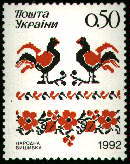 I
shared my 4-person 2nd class sleeper cabin (UAH 30 or US$7) with an amorous
young couple who spent half the time in each other's arms, and who would
no doubt have gone further with their affections if not for my presence...
When I asked them whether they knew English “Vi gava ritye pa-angliski
?”, Nyet was the reply. Certainly, would you have bothered to speak
to a boring looking foreigner when there were more enjoyable carnal pleasures
?
I
shared my 4-person 2nd class sleeper cabin (UAH 30 or US$7) with an amorous
young couple who spent half the time in each other's arms, and who would
no doubt have gone further with their affections if not for my presence...
When I asked them whether they knew English “Vi gava ritye pa-angliski
?”, Nyet was the reply. Certainly, would you have bothered to speak
to a boring looking foreigner when there were more enjoyable carnal pleasures
?
It was only when I was seen trying to decipher the rail schedule chart that I was asked, in English, whether I needed any assistance. So they do know English after all.
“Da, a little,” the chap answered. Many people in the CIS have actually studied English in schools but the lack of opportunity to practice it meant that they lack the confidence to speak the language even if such an opportunity arises.
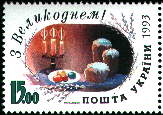 Stamp commemorating the Easter, traditional the most important festival
in Ukraine.
Stamp commemorating the Easter, traditional the most important festival
in Ukraine.
Anton and Anatashia were on their way back to Odessa after a Yalta holiday. Anton is a Moldovan from Balti (pronounced “Belts”) and is now working as a mechanic in Odessa. Anatashia is Ukrainian, a home-grown Odessan, now in police training school. Given my so-far negative experiences with the Ukrainian police, I can’t help but wondered how long it would take this sweet, pretty girl to turn into the kind of nasty, corrupt bureaucrat I have bumped into on this trip.
We had an interesting conversation about life in Odessa, wonderful Crimea, the never-ending battle between Moldovan and Crimean wines (which of course pitted Anton against Anatashia), and the confusing identity of being Moldovan or Romanian. Before long, we were sharing fruits and tidbits, and Anton even taught me how to turn on the Russian, or rather, to be politically correct, the Ukrainian train toilet tap, which is so different from any other taps I have seen elsewhere. Nothing for you to turn on, but a little pressable metalpiece behind the nozzle. What an introduction to the great samovar tradition of CIS trains – Gentlemen, it’s self-service tea-time !
| RETURN TO FROM THE BALTIC TO THE BLACK SEA HOMEPAGE |